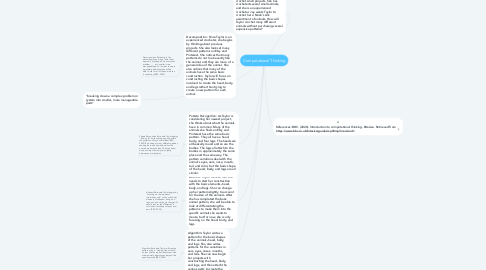Computational Thinking
by Christina Durfee

1. "breaking down a complex problem or system into smaller, more manageable parts"
2. Algorithm: Taylor writes a pattern for the basic shapes of the animals--head, body, and legs. She also writes patterns for the variations in ears, eyes, noses, mouths, and tails. She can now begin her projects with constructing the head, body, and legs, and then attach the various parts to create the different animals.
2.1. Algorithm Rationale: Taylor will create a pattern using a "step-by-step solution" so that she can repeat the process with other animal patterns even beyond this specific project (BBC, 2020).
3. Abstract: Taylor realizes that she needs to start her construction with the basic elements--head, body, and legs. She can change up her pattern slightly to account for the size of the animals. After she has completed the basic animal pattern, she will be able to look at differentiating the patterns to make them into the specific animals she wants to create, but for now, she is only focusing on the head, body, and legs.
3.1. Abstract Rationale: Taylor begins by "focusing on the important information only" such as the basic elements of the head, body, and legs, and she will ignore the specific details such as the differences in colors and the shapes of eyes and ears (BBC, 2020).
4. Pattern Recognition: As Taylor is considering her newest project, she thinks about what the animals have in common. Many of the animals she finds on Etsy and Pinterest have the same basic pattern. They all have a head, body, and four legs. The heads are all basically round and so are the bodies. The legs all attach to the bodies in approximately the same place and the same way. The pattern variations deal with the animal's eyes, ears, nose, mouth, tail, and color, but the basic shape of the head, body, and legs are all similar.
4.1. Pattern Recognition Rationale: Taylor begins "looking for similarities among and within" the patterns on Etsy and Pinterest (BBC, 2020). By looking at many different patterns, she begins to see how truly similar the animals are because they all have a head, body, and legs that vary only slightly between animal patterns.
5. Decomposition: Since Taylor is an experienced crocheter, she begins by thinking about previous projects. She also looks at many different patterns on Etsy and Pinterest. She notices that many patterns do not look exactly like the animal, and they are more of a general idea of the animal. She also notices that many of the animals have the same basic construction. Taylor will focus on constructing the basic shapes involved to create the head, body, and legs rather than trying to create a new pattern for each animal.
5.1. Decomposition Rationale: In the decomposition a stage, Taylor must begin by "breaking down a complex problem . . . into smaller, more manageable parts" in order to create a general pattern that she will be able to use for all of the animals she is crocheting (BBC, 2020).
6. Problem statement: Taylor loves to crochet small projects. She has crocheted several small animals, and she is an experienced crocheter. Jay wants Taylor to crochet her a Noah's Ark assortment of animals. How will Taylor crochet many different animals without purchasing several expensive patterns?
7. References: BBC. (2020). Introduction to computational thinking. Bitesize. Retrieved from https://www.bbc.co.uk/bitesize/guides/zp92mp3/revision/1


